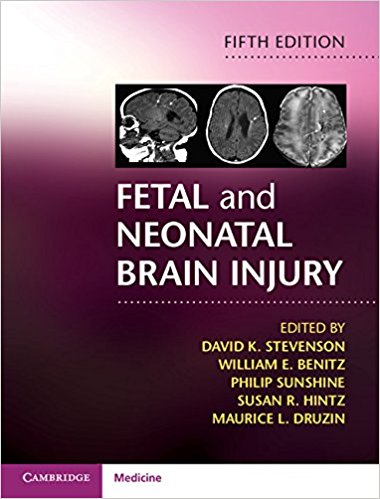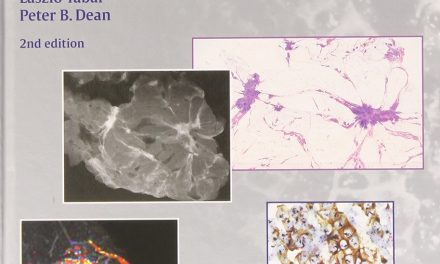 Editors: David K. Stevenson, William E. Benitz, Philip Sunshine, Susan R. Hintz, and Maurice L. Druzin
Editors: David K. Stevenson, William E. Benitz, Philip Sunshine, Susan R. Hintz, and Maurice L. Druzin
Publisher: Cambridge University Press – 831 pages
Book Review by: Nano Khilnani
In the last several decades, a great deal of knowledge has been discovered and gathered about the causes, diagnosis, and treatment of brain injury on pre-term, near-term, term, and newborn infants. This book provides the newest information on this subject.
Eighty-one contributors including five editors, who work to care for expectant mothers and their yet-to-be born or newborn babies at risk for brain injury, authored the 49 chapters of this large and extensive book on fetal and neonatal brain injury.
They are from all over the United States and six other countries: Canada, Israel, Italy, the Netherlands, New Zealand, and Switzerland. They are recognized experts in their respective specialties relating to brain injury among this group of patients.
They not only have up-to-date knowledge of the topics they write about in this book in terms of the most current research, but also the practical clinical experience and insight they have developed that is needed to correctly diagnose diseases and disorders, and to come up with optimal treatment options.
The chapters of this thick book of 800+ pages, too numerous to list here, are organized around four Sections, namely:
- Section 1. Epidemiology, Pathophysiology, and Pathogenesis of Fetal and Neonatal Brain Injury
- Section 2. Pregnancy, Labor, and Delivery Complications Causing Brain Injury
- Section 3. Diagnosis of the Infant with Brain Injury
- Section 4. Specific Conditions Associated with Fetal and Neonatal Brain Injury
This book has been a commercial success with its wide reach and use among medical students, residents, and practicing specialists, beginning with its first edition that was released in 1989. Subsequent editors provided updated knowledge as it accumulated over the years.
The fact that a fifth edition was published in 2018 reflects high demand for such a book. Also, new findings in the field, discovered through research and practice, are typically disseminated with the release of new, updated editions.
Numerous conditions, disorders and diseases – too many to name in this review – are covered and discussed in this book. Among the more well-known and more frequently-encountered ones are: neonatal asphyxia, and hypoxic-ischemic encephalopathy (HIE) in both term and near-term infants, as mentioned by the authors Matthew R. Wallenstein and Philip Sunshine of chapter 9, Neonatal Encephalopathy – Epidemiology and Overview.
The chapters cover these and related topics:
- Acidosis and alkalosis; antepartum evaluation of fetal well-being
- Bacterial sepsis in the neonate
- Cellular and molecular biology of hypoxic-ischemic encephalopathy; cerebral palsy: advances in definition, classification, management and outcome; congenital malformations of the brain
- Early outcomes after extremely preterm birth; extended management following resuscitation; endogenous and exogenous neuro-protective mechanisms after hypoxic-ischemic injury
- Fetal and neonatal injury as a consequence of maternal substance abuse; fetal responses to asphyxia
- Hemorrhagic lesions of the central nervous system; hydrops fetalis; hyperbilirubinemia and kernicterus; hypertensive
- Improving performance, reducing error, and minimizing risk in the delivery room; inborn errors of metabolism and single-gene disorders with features of neonatal encephalopathy; intrapartum evaluation of the fetus; intrauterine growth restriction
- Light-based assessment of the brain
- Maternal diseases that affect fetal and neonatal neurodevelopment; medicolegal issues in perinatal brain injury
- Neonatal bacterial management; neonatal encephalopathy; neonatal neuroethics; neonatal resuscitation; neonatal seizures; neonatal stroke; neurocognitive outcomes in term infants with neonatal encephalopathy
- Neurodevelopmental consequences of neonatal hypoglycemia; neurodevelopmental and neurobehavioral outcomes of pregnancy; neurodevelopmental neurologic complications of perinatal human immunodeficiency virus; neurogenetic disorders of the brain; neuroimaging in the evaluation of pattern and timing of fetal and neonatal brain abnormalities.
- Neurologic sequelae of congenital and perinatal infections; neuronal cell death mechanisms relevant to humans: rethinking modeling neonatal hypoxic-ischemic encephalopathy; nutritional support of the asphyxiated infant;
- Obstetric conditions and practices that affect the fetus and the newborn
- Pathogenesis of preterm brain injury; pediatric cardiac surgery; prematurity and complications of labor and delivery; placental pathology and etiology of fetal and neonatal brain injury; polychemia and fetal-maternal bleeding;
- Risks and complications of multiple gestation
- Timing perinatal hypoxic-ischemic brain injury
- Use of EEG and aEEG in assessing the term and preterm brain
This book provides not only an overview of significant changes and advances that have occurred in recent years in diagnosing the myriad fetal and neonatal brain disorders and diseases, but also an extensive overview of the treatment options available for their management. It is an excellent, valuable text written, edited, and presented by recognized specialists in the field.
Editors:
David K. Stevenson is the Harold K. Faber Professor of Pediatrics, Senior Associate Dean for Maternal and Child Health, and co-Director of the Stanford Child Health Research Institute.
William E. Benitz is the Philip Sunshine MD, Professor and Chief of the Division of Neonatal and Developmental Medicine at Stanford University. He is a member of numerous academic societies and has served as Chair of the American Board of Pediatrics’ Sub-Board of Neonatal-Perinatal Medicine.
Philip Sunshine is Professor Emeritus at the Lucille Packard Children’s Hospital at Stanford University. He has received numerous honors throughout his career, including the Virginia Apgar Award. His primary research interests are in the areas of neonatal nutrition and developmental gastroenterology.
Susan R. Hintz, MD, MS is the Robert L. Hess Family Professor and Associate Chief of Neonatology for Prenatal Services at Stanford University, as well as Medical Director for the Fetal and Pregnancy Health Program at Lucille Packard Children’s Hospital Stanford.
Maurice L. Druzin is Professor and Vice Chair of the Department of Obstetrics and Gynecology at Stanford University. His focus is on fetal assessment and medical complications of pregnancy, He served on the American College of Obstetricians and Gynecologists Hypertension in Pregnancy Taskforce.







